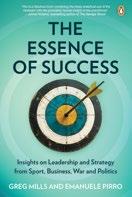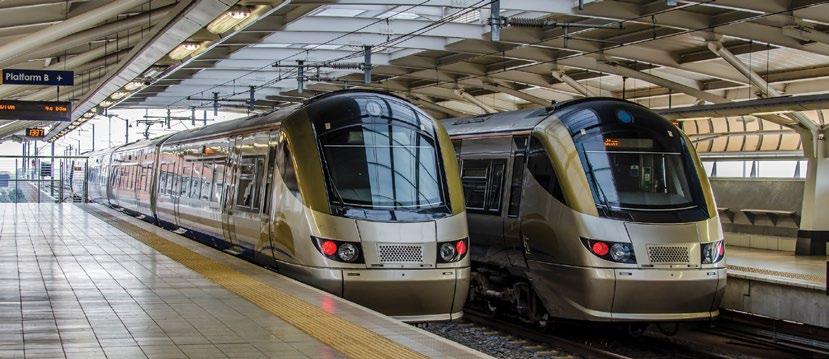














In this edition of Inbound SA’s Business section, we pause the holiday rush to focus on developments shaping South Africa’s economic future.
We explore the county’s journey towards tech resilience, where digital infrastructure and innovation are becoming essential to economic stability and long-term growth in an everchanging global market.

Our property feature examines what happens when deals fall through. In business, not everything goes according to plan, and we share expert strategies on how to recover, reposition and move forward confidently when unexpected challenges arise.
We also unpack the rapid transformation in South Africa’s payments landscape. From tap-and-go to instant transfers, fintech developments and changing consumer behaviour are redefining how money moves – and businesses need to adapt to stay competitive.
Our mission remains the same – to inform, inspire and empower South African businesses with insights that drive action and resilience.
Happy reading!
Venecia Valentine
Editor

Choose from 19 hotels and resorts across South Africa – from coast to bush. Enjoy two nights for two, breakfast included, and experience the comfort and charm of ANEW’s signature hospitality.

Prize valid for six months. To enter, scan the QR code and follow the entry instructions.
T&Cs apply. Competition closes on 30 November 2025.

BUSINESS: THE
BUSINESS: POWER PLAYERS: THE INDUSTRIES REDEFINING SUCCESS
BUSINESS CONTINUITY: HOW SA BUSINESSES CAN ADAPT AND LEAD
MEET THE
MEET THE
ANGELIQUE KUIPER
LOURANDI KRIEL
CYBERSECURITY:





HUMAN RESOURCES: LEARNING FROM RAPTURE-GATE
RETAIL DISRUPTION: TO SHEIN OR NOT TO SHEIN
PROPERTY: FALLING THROUGH THE CRACKS
TECH: SA’s PATH TO TECH RESILIENCE
BLEISURE TRAVEL: 24 HOURS IN JOHANNESBURG
ADVERTORIAL:
The year’s been one long meeting and the minutes just kept adding up. As you log off from work mode and check into summer mode, know that with Avis 4-For-3 Summer, you get a day on us to chase the sun, the sea, or simply silence. Book 4 days, pay for 3, and make your summer trip worthwhile. .Go to avis.co.za and make this summer unforgettable. The Avis 4-For-3 Summer is here. Book 4 days and pay for 3. Your excuse to get out of town.


BY VENECIA VALENTINE
POLYCO CEO PATRICIA PILLAY SHARES HOW COLLABORATION, INNOVATION AND EXTENDED PRODUCER RESPONSIBILITY (EPR) ARE RESHAPING SOUTH AFRICA’S PLASTICS INDUSTRY AND DRIVING A SUSTAINABLE CIRCULAR ECONOMY.
COULD YOU GIVE A BRIEF OVERVIEW OF POLYCO AND ITS ROLE IN SOUTH AFRICA’S PLASTICS RECYCLING SECTOR?
Polyco is a non-profit Producer Responsibility Organisation (PRO) committed to promoting the circular economy for plastic packaging. We collaborate with producers, recyclers, collectors, municipalities and waste reclaimers to increase collection and recycling rates, minimise plastic pollution, and ensure compliance with Extended Producer Responsibility (EPR) regulations.
Through strategic investments in infrastructure, innovation, and enterprise development, Polyco helps create jobs, professionalise the recycling sector, and ensure that plastic packaging is recovered and reprocessed as a valuable resource rather than ending up in landfills or the environment.

EPR is a policy tool that ensures producers take responsibility for the entire lifecycle of the products they place on the market, especially for the stage after consumers use and dispose of them. In practical terms, this means that producers must help fund and support the collection, sorting, and recycling of post-consumer waste. In South Africa, EPR became mandatory in 2021, and it’s already transforming the way we manage plastic packaging. EPR encourages better product design, reduces waste, and promotes accountability. It also enables investment in the recycling value chain, from infrastructure and equipment to community collection programmes and enterprise development. At its core, EPR is about ensuring that sustainability isn’t just a niceto-have but a shared, system-wide responsibility. It helps close the loop between what’s produced, what’s consumed, and what gets recovered.
Mandatory EPR has driven tangible change across South Africa’s plastics value chain. For producers, it has meant rethinking packaging choices, from reducing problematic materials to investing in recyclable design. Many are now actively funding collection and recycling programmes through PROs, like Polyco, giving them a more hands-on role in end-of-life solutions. For recyclers, EPR has unlocked new funding to expand infrastructure, improve material recovery rates, and raise operational standards across the sector. It has also helped bring more informal reclaimers into the formal recycling economy, not only through training and partnerships, but by creating income opportunities, improving working conditions, and recognising their role in the value chain. Small and emerging enterprises have benefited too, with increased access to support and equipment. While the system is still maturing, the biggest challenge remains addressing non-compliant “free-rider” producers who sidestep their legal obligations. This is an area requiring stronger enforcement and collaboration.
At Polyco, we manage EPR contributions with a straightforward goal in mind. To get the greatest environmental and social return from every
rand, and to do so transparently and responsibly. That means investing in projects that do not just look good on paper but actually shift the dial, whether by growing plastic recycling volumes, creating jobs in local communities, or making it easier for producers to choose more sustainable packaging. Every investment is tracked, reported on, and measured because accountability to both producers and the public is non-negotiable. We look for three things in any project we fund - scale (can it create real change nationally?), staying power (will it last beyond our funding?), and inclusion (are people across the value chain, including waste reclaimers, able to benefit?). Since EPR’s inception, we have invested over R303 million into the plastics collection and recycling space and helped divert more than 450 000 tonnes of plastic waste from landfill and the environment. It is about building a system that works and lasts.
ESPECIALLY THOSE JUST STARTING. AND WHILE MANY PRODUCERS ARE STEPPING UP UNDER EPR, SOME STILL DON’T COMPLY, UNDERMINING THE SYSTEM FOR EVERYONE ELSE.
CAN YOU SHARE EXAMPLES OF PROJECTS THAT DEMONSTRATE EPR FUNDING IN ACTION?
• Through EPR funding, Polyco invested over R180 million in 2024 in nationwide recycling and collection initiatives. Highlights include:
• Packa-Ching, our mobile community recycling programme, has paid over R24 million directly into communities while diverting more than 27 million kilograms of waste from landfill to date.
• R96 million was invested in six capital expenditure projects with local recyclers. These projects strengthened local processing of polyolefins, PET, and multilayer plastics, and introduced new technologies to improve recyclate quality.
• Polyco’s Enterprise Development Programme funded 17 black-owned, Level 1 BBBEE companies with more than R7.6 million in grants, while also providing certified youth business training, bursaries, and scholarships to build future-ready skills in the sector.
• In municipal partnerships, Polyco supported the launch of five new buy-back centres in Buffalo City Metro and signed six new MOUs with municipalities to align public infrastructure with EPR goals. In total, we engaged 95 municipalities across all nine provinces.
• To strengthen the role of waste reclaimers, we facilitated monthly payments to over 1 300 registered pickers via our Weigh Pay app. We channelled R9 million into dignity-focused initiatives, including PPE distribution and reclaimer hubs.
• Our public education campaigns reached 2 500 schools and nearly 2 million learners through the Million+ programme.
• Through Polyo’s programmes and partnerships, 2 593 new jobs were created or sustained across the value chain.
These initiatives show how EPR drives economic, social, and environmental impact.
The plastics recycling sector in South Africa faces some tough hurdles. Virgin plastic is often cheaper than recycled material, making it hard for recyclers to compete. On top of that, contaminated waste streams and poor separation at source mean recyclable plastic is still ending up in landfills. Poor electricity access hits small recyclers hard, especially those just starting. And while many producers are stepping up under EPR, some still don’t comply, undermining the system for everyone else. At Polyco, we’re tackling these issues from multiple angles, including investing in new infrastructure, helping recyclers scale, advocating for more vigorous enforcement, and supporting innovations that make sorting and recovery more efficient. There’s a long way to go, but progress is being made.
Collaboration is essential. No one organisation, company, or government department can build a circular economy on their own. At Polyco, we work closely with government to shape and implement policy and ensure compliance, with industry to encourage more innovative packaging and greater recyclability, and with waste reclaimers who are on the frontlines of collection. We’re also focused on connecting the dots between formal systems and the informal sector, so the benefits of recycling are shared more fairly and the system functions better overall. But there’s another piece of the puzzle: the public. Households, schools, and everyday citizens play a massive role in separating waste and keeping recyclables clean and out of landfills. Real change happens when all parts of the system pull together, and that includes you and me.
Much of what we’ve talked about – from expanding recycling infrastructure to empowering reclaimers and innovating around packaging – feeds into our broader strategic priorities. In the years ahead, we’re focused on building on these foundations and pushing for even greater impact through four key focus areas:
• Expanding national reach and recycling impact by increasing plastic collection capacity, setting up more hubs in underserved areas, and reducing the amount of plastic leaking into the environment.
• Improving compliance to ensure that all producers play their part and that the EPR system remains financially sustainable.
• Backing innovation, from new ways to recover waste to investment in circular product design and solutions for hard-torecycle plastics.
• Deepening inclusion by supporting greeneconomy entrepreneurs and linking informal reclaimers more directly into the formal value chain, with a continued focus on youth, women, and people with disabilities.
At the heart of it all is our belief that a circular plastics economy must work for both people and the planet, and our job is to help make that a reality, step by step. IB












BY WENDY MONKLEY OF THE IMM INSTITUTE
SOUTH AFRICA’S SIDE HUSTLE GENERATION IS TRANSFORMING WORK THROUGH CREATIVITY, AI TOOLS AND PURPOSE-DRIVEN INDEPENDENCE.
Welcome to the age of the Side Hustle Generation, where a 9-to-5 job is optional and multi-hyphenate careers are common. South Africans are spearheading a work revolution driven by creativity, independence and AI-powered tools.
The IMM Institute explains why this change is important, not only for the workforce but also for marketers aiming to connect with a generation
that values meaning, flexibility and purposedriven brands.
WHY NO ONE WANTS A 9-TO-5
It’s 8.59am and a young professional in Johannesburg isn’t stuck in traffic or pouring coffee in a boardroom. Instead, she has already finished a graphic design brief for a client in the UK, uploaded a YouTube video on passive income and is halfway through editing a fashion reel for

her Instagram side hustle. Welcome to the rise of the Side Hustle Generation, a generation that is redefining what it means to “work”.
The traditional 9-to-5 model, once a symbol of stability and success, is losing its appeal. Millennials and Gen Z are abandoning the cubicle in favour of flexibility, autonomy and purpose-driven work. Why the change? It’s not just about money, though that’s part of it.
workforce prioritises purpose, mental wellbeing and flexibility. They want to travel, spend time with family, volunteer and avoid burnout, all while creating income streams that reflect their passions and personalities. A 9-to-5 can feel restrictive in comparison.
Here’s the key point: brands and marketers need to pay attention. This isn’t a passing trend; it’s a movement. The Side Hustle Generation isn’t just consuming differently; they’re working differently, thinking differently and expecting brands to meet them where they are. Marketing strategies now must speak to the multi-hyphenates: the barista-photographer-podcast host or the accountant-candle-maker-influencer. They seek products, platforms and services that support their ambitions, not just fill a shopping cart.
“IT’S ABOUT CONTROL, CREATIVITY, AND THE ABILITY TO DIVERSIFY INCOME STREAMS IN A VOLATILE ECONOMY.” - IMM INSTITUTE.
The Covid-19 pandemic didn’t initiate this revolution, but it certainly sped it up. As companies restructured, scaled back and remote work became standard, people realised they could earn, and often more, without the costs of traditional employment. With just a smartphone, a Canva account, and a dream, you could sell products, offer freelance services, teach online or build a brand.
South Africans, in particular, are natural-born hustlers. Faced with high unemployment rates and a rising cost of living, many are turning side hustles into essentials for survival. Whether it’s baking custom cakes, tutoring online, flipping thrifted fashion or trading on the JSE, side hustles are no longer just weekend projects; they are becoming people’s main source of energy.
But it’s not just about economics. There’s also a generational shift in values at play. Today’s
The truth is, many side hustlers are already actively utilising AI, often without even realising it. From scheduling posts and writing captions to monitoring what’s performing well online, AI is becoming a useful tool for small businesses and solo creators.
The future of work remains flexible and the Side Hustle Generation has only just begun. If you’re targeting them, or are one of them, the message is clear: passion holds power, and work is whatever you make of it. IB
• Freelancing digital services
• E-commerce or dropshipping
• Content creation and monetisation
• Beauty and grooming / Skillsbased local services
• Online tutoring and teaching
• Reselling (preloved / secondhand items)

BY BYRON LUKAS
IN A YEAR MARKED BY INNOVATION AND ADAPTABILITY, SOUTH AFRICA’S LEADING SECTORS – FROM RENEWABLE ENERGY AND FINTECH TO AGRICULTURE, REAL ESTATE, AND TOURISM – ARE DEMONSTRATING THAT RESILIENCE PAYS OFF.
South Africa’s business landscape in 2025 narrates a story of resilience, reinvention and adaptability. Despite ongoing economic challenges – from volatile energy costs to global inflation – several industries have not only persisted but also prospered, discovering new ways to convert obstacles into opportunities.
Across renewable energy, agriculture, fintech, real estate and tourism, South African businesses are showing that innovation and focus are still the most powerful forces driving growth.
With load shedding looming large, South Africa’s energy deficit has emerged as one of the decade’s most significant business opportunities Renewable energy (especially solar, battery storage, and off-grid solutions) has advanced as the most lucrative sector in 2025.
From vast solar farms in the Northern Cape to sleek home inverter systems in Johannesburg’s suburbs, renewable energy is no longer a niche investment; it’s the new gold rush. Independent power producers and smaller renewable start-ups
are reporting record margins, driven by consumer demand, government incentives and corporate sustainability goals.
Businesses providing complete energy solutions – from installation and maintenance to financing – are at the forefront, demonstrating that South Africa’s energy crisis has become the driving force behind a green business surge.
Agriculture continues to be one of the country’s most reliable sources of profit. Farmers and agribusinesses that have expanded beyond production into processing and export.
South Africa’s fruit, nut and wine industries continue to perform remarkably well, driven by global demand for premium, sustainably sourced products. Technologies such as precision irrigation, drone mapping and soil monitoring are revolutionising farming efficiency and yields, while exporters are benefiting from favourable exchange rates.
However, challenges remain. Recent US tariffs on certain agricultural imports have added pressure for some exporters, particularly in niche markets areas like the citrus belt and the Cape Winelands, agro-processing companies are adding value and generating employment – transforming raw produce into branded global products that enhance South Africa’s agricultural reputation.
Financial technology continues to be one of the country’s fastest-growing and most transformative sectors. In a nation where many still lack access to traditional banking, fintech companies are bridging the gap with inclusive, mobile-first solutions tailored to underserved communities.
Payment innovators like Yoco and Ozow have transformed convenience, providing digital tools for small businesses and informal traders. The 2025 rise in mobile credit, micro-savings and insurance apps underscores a trend towards financial accessibility and profitability through scale.
Once trust is established, these platforms expand rapidly, converting low transaction fees into sustainable revenue streams that transform South Africa’s financial landscape.
Despite elevated interest rates, the real estate market in South Africa continues to show resilience, with particularly strong performance in affordable rental housing in areas such as Cape Town’s outlying suburbs, as well as in Durban and Johannesburg. While the broader market faces challenges, demand for rental properties in these regions remains stable, offering the potential for consistent returns. In fact, national rental vacancies are at their lowest in eight years, indicating robust demand for rental housing.
Industrial and logistics properties are also flourishing, driven by the e-commerce surge and the demand for warehousing and last-mile distribution centres. Developers investing in mixed-use, green-certified projects are enjoying the best returns.
Township property development is also emerging as a promising frontier, offering both social impact and solid financial performance – a balance increasingly appreciated by investors.
After a tumultuous lockdown period, South Africa’s tourism industry is showing strong signs of recovery. In 2025, international arrivals rose by over 15% year-on-year, with travellers drawn to the country’s natural diversity, conservationfocused lodges and authentic community experiences.
Eco-lodges, boutique hotels and adventure travel operators are spearheading this revival. Many are adopting the “conservation without borders” approach – combining wildlife preservation with local empowerment. Destinations in Limpopo, KwaZulu-Natal and the Western Cape are thriving as visitors pursue sustainable, culturally rich experiences that benefit local communities.
If 2025 has proven anything, it’s that South Africa’s greatest strength lies in its ability to adapt.
This year’s business winners aren’t just generating profits – they’re redefining what success means in a rapidly changing economy. South Africa’s future belongs to those brave enough to reinvent it. IB







BY TARRYN-LEIGH SOLOMONS
AMID ECONOMIC UNCERTAINTY, SOUTH AFRICAN BUSINESSES MUST ADAPT FAST. SMART STRATEGY, TECHNOLOGY AND SKILLS DEVELOPMENT ARE KEY TO STAYING RESILIENT AND COMPETITIVE.
South African companies are facing a period of uncertainty. Rising inflation, currency swings, changing regulations and sporadic protests are putting more pressure on every sector. However, volatility does not necessarily mean failure. Resilience isn’t just about enduring difficult times – it’s about adapting, reinventing and spotting opportunities in change.
The current economic picture is mixed. Inflation has cooled from previous highs, but pressure points remain.
• February 2025: Annual consumer inflation held steady at 3.2%, with a monthly increase of 0.9%.
• March 2025: Inflation dropped to 2.7%, its lowest since mid-2020, due to falling fuel prices and slower growth in education costs.
• April 2025: A slight rise to 2.8%, still below the South African Reserve Bank’s 4.5% midpoint target.
• July 2025: Inflation rose to 3.5%, driven by food and fuel costs.
• Food and non-alcoholic beverages: Up 2.8% year-on-year in February 2025.
• Growth outlook: Mastercard forecasts 1.7% GDP growth for 2025, with consumer spending set to rise 1.9% and inflation averaging 4.2%.
• SME performance: Despite challenges, 83% of South African SMEs reported revenue growth over the past year.
These figures reflect a nuanced reality. While headline inflation has eased, sector-specific costs – particularly in food, energy, and logistics –remain elevated. Businesses are expanding, but success now requires more precise strategies and increased financial discipline.
According to Dawie Roodt, Chief Economist at Efficient Group, the macroeconomic outlook remains more challenging than many forecasts suggest.
“I don’t think we’ll see the 1.7% economic growth as forecasted – I believe it will be closer to 1%,” says Roodt. “The world is changing fast, and South Africa needs people with the right skills to thrive in a modern, service-driven economy. Technology and safety are also crucial – especially in a country where crime is high. Safety should be a key consideration, too.”
He also credits the South African Reserve Bank for stabilising inflation amid government inefficiencies.
“Fortunately, the Reserve Bank has done an excellent job. Despite destructive policies elsewhere, it has helped shield South Africans from runaway inflation.”
In this environment, resilience means adapting quickly, planning proactively, and staying competitive under pressure to thrive in uncertainty. Here’s how businesses can stay ahead.
Maintain strict control over operational costs. Negotiate better terms with suppliers, explore alternative sourcing options, and fix prices where possible to reduce volatility. Introduce pricing flexibility – through costplus, tiered, or dynamic models – to safeguard margins without losing customers or compromising long-term competitiveness.

For businesses exposed to exchange rate risks, tools such as forwards and options can help reduce volatility. Conduct scenario planning for best, moderate and worst-case outcomes to inform investment and liquidity decisions. Keep cash reserves to respond quickly in uncertain conditions.
Infrastructure strain and global disruptions have revealed vulnerabilities. Localise essential supply chain elements, diversify supplier networks and develop contingency plans. Invest in backup solutions for energy and transport to minimise downtime.
Simplify structures to boost agility. Shorter planning cycles, quick feedback loops and empowered teams enable faster responses to change. Flatten hierarchies to accelerate decisionmaking and execution.
Digital transformation remains a key differentiator. Upskilling staff and adopting automation, AI and analytics enhance both efficiency and competitiveness. A recent SME survey found 42% plan to invest in staff development and 39% in digital tools within the next year.
Resilient companies rely on trust. Be transparent with staff, customers and partners about challenges, pricing changes and strategic shifts. Open communication fosters loyalty and keeps teams aligned.
Load shedding, strikes and policy shifts can disrupt operations overnight. Develop contingency plans that include insurance coverage, alternative suppliers and flexible contracts. Consider risk planning an operational priority.
Now is not the time for reckless expansion. Focus on core services, established customer bases and operational strengths. Specialisation and strong relationships foster stability and build brand trust in volatile markets.
South African businesses understand complexity. The goal isn’t just to survive uncertainty – it’s to use it as a catalyst for reinvention. Companies that combine strategic foresight with operational agility and invest in their people can turn turbulence into progress. Resilience, after all, is not built in calm waters –it’s forged in the storm. IB
BY TARRYN-LEIGH SOLOMONS
AFTER A GLOBAL CAREER WITH SABMILLER AND MOLSON COORS, ANGELIQUE KUIPER ESTABLISHED RESONANCE – A COMPANY REDEFINING HOW BRANDS AND TALENT COLLABORATE. SHE OFFERS INSIGHTS ON LEADERSHIP, AUTHENTICITY AND CREATING CULTURAL IMPACT.
WHICH LESSONS FROM SABMILLER AND MOLSON COORS HAVE MOST INFLUENCED YOUR LEADERSHIP OF RESONANCE?
My time at SABMiller and Molson Coors showed me that the power of building brands that truly connect with people comes not only through marketing but also through culture. Managing global portfolios across more than 50 countries highlighted the importance of balancing strategic consistency with local authenticity. I also discovered that success relies on relationships and genuinely understanding people’s needs, whether they are consumers, colleagues or partners. Collaboration, empowerment and a clear sense of purpose are what foster genuine performance, and those insights now shape my approach to leading my company today. Our culture reflects that balance – insight-led, creative and commercially grounded.
WHAT WAS THE KEY MINDSET CHANGE WHEN TRANSITIONING FROM GLOBAL LEADERSHIP TO ENTREPRENEURSHIP?
The biggest shift was moving from leading within a vast, structured global system to creating one from scratch. In corporate life, resources and processes are plentiful; in entrepreneurship, you exchange that for agility, ownership and

the ability to shape things in real time. I had to unlearn comfort with scale and relearn the power of focus, adaptability and experimentation. It’s been a return to pure brand-building – close to the work, the people and the impact.
WHAT INSPIRED THE DEVELOPMENT OF RESONANCE AND WHAT GAP DOES IT INTEND TO ADDRESS?
I founded Resonance to pursue my dream of working in the entertainment and talent industry, helping to develop exciting brands within this field. After years of leading global brands and working closely with partners in film, music, fashion, sport and entertainment, I noticed a significant gap in how brands and talent were connected – often driven by commercial opportunities rather than genuine alignment. Our approach begins by stepping back to thoroughly understand what both the brand and the talent represent, ensuring their values, audiences and ambitions naturally align. From this foundation, we craft strategies and content that bring these collaborations to life – fostering cultural impact, authentic audience engagement and sustainable brand growth.
RESONANCE CONCENTRATES ON THE “MULTIPLIER EFFECT” AMONG BRANDS, TALENT AND AUDIENCES. HOW CAN YOU BRING THAT TO LIFE?
The “multiplier effect” occurs when a brand

and a talent that are naturally aligned through shared positioning, values and cultural relevance come together. The impact of that partnership becomes much greater than what either could achieve alone. To achieve this, we begin by thoroughly understanding both sides – who they are, what they represent and how their audiences connect. When we identify those synergies, the result is what we call the magic multiplier effect: collaborations that feel authentic, spark cultural relevance and generate measurable brand and audience growth. We bring this to life through strategy, storytelling and content that amplifies both voices in a way that resonates well beyond a single campaign.
HOW HAS LEADING A GLOBAL, ONDEMAND NETWORK INFLUENCED YOUR APPROACH TO COLLABORATION AND DELIVERY?
Leading a global network requires building trust, clarity and genuine connection across borders. I’ve learned to lead through outcomes rather than presence, empowering specialists to deliver their best work wherever they are. Technology enables collaboration, but mindset sustains it through transparency, empathy, communication and shared ownership. This approach has made us faster, more adaptable and seamlessly integrated across time zones and disciplines. What makes Resonance truly unique is that our team works on projects that align most closely with their strengths and passions, ensuring the most authentic expertise and the best possible results for our clients.
THROUGHOUT YOUR CAREER, WHICH LEADERSHIP PRINCIPLES HAVE STAYED CONSISTENT – NO MATTER THE INDUSTRY OR ROLE?
I believe it’s essential to understand humanity and what people are experiencing, both personally and professionally, to achieve true success. Work should always support life, not define it, and recognising that we are all part of a bigger picture influences how I lead. I aim to work with people and clients
who are kind, respectful and collaborative because genuine connection drives better outcomes. Whether guiding a multinational brand or a startup team, I combine strategy with humanity by setting clear direction, empowering people and maintaining a focus on culture and consumers. At the core are three principles that continue to guide me: integrity, curiosity and creativity. IB






OPTION 1:
PROPERTY WITH ALL ASSETS AS A GOING CONCERN OPTION 2:
GOING CONCERN WITH ALL ASSETS, AND A LEASE AGREEMENT ON THE PROPERTY
PROPERTY: Ptn 2 of Farm Wildebeestfontein 225
Prime fenced bushveld. Total Extent: ± 192 ha
Approved rights for public resort
GENERAL RESORT IMPROVEMENTS: (www.kokoriba.co.za)
Ÿ 47 air conditioned self catering chalets
Ÿ Conference center with own lapa
Ÿ `A la carte restaurant, licensed bar, mini market & salon
Ÿ 6 pools (2 heated), slides, Tiki-bar, hiking & game viewing
Ÿ Mini golf, table tennis etc. & children’s play area
Ÿ Office building with reception & 11 storerooms
Ÿ Private runway, a compacted 850 m long North/South fenced track, workshop, staff housing: 2 x 3 bed houses, 4 apartments & a student residence (16 beds).
101 BUSHVELD CARAVAN STANDS: With water & electricity points, 6 communal ablutions, a wheel chair friendly ablution & 12 private ablutions stands, as well as a Laundromat.
ACCOMMODATION: 208 BEDS (Air-conditioned)
KUDU CAMP: 14 x 4 beds luxury self-catering chalets
OUKAMP: 7 x self-catering chalets (2,4,5 or 6 beds)
BUNDU CAMP: 9 x 4 beds self-catering log cabins
KOKOK CAMP: 6 x 4 beds self-catering chalets
MAKORO BASE: Ideal for groups with private lapa, braai facilities & fully equipped lock-up kitchen for ± 35 people, 11 x 2 bed & 2 x 5 bed rooms & ablutions
IGLO CAMP: 4 x 4 beds spacious self-catering chalets
SABLE CAMP: 6 x 2- beds luxury self-catering tent houses
DUIKER: 1 x 4 bed self catering chalet


GAME FARM & RESERVE:

123 ha open farm where guests can hike, cycle & do rental game drives. All fenced (2.4m high, 21 strands), with 3 private game breeding camps. Eskom electricity & ample water, equipped boreholes, reservoirs, gravel dam, irrigation etc.
PRIVATE MAIN HOUSE: (± 460m²)
Newly built stylish house with 5 bedrooms, 4 bathrooms, kitchen, pantry, scullery, dining, living, TV room, patio etc.
MOVABLES & GAME: All movables, vehicles, game viewers, tractors, trailers, scrapers, generators, 200kw boiler as well as various game included.
INCOME & RATES:
Excellent income, full details in Invitation pack.








BY TARRYN-LEIGH SOLOMONS
IN EARLY OCTOBER, UNDER CEO LOURANDI KRIEL’S LEADERSHIP, SWEEPSOUTH WON TOP AWARDS AT THE G20 ICT SMME AWARDS, VALIDATING ITS MISSION TO SCALE AFRICA’S TECH ECONOMY. THIS GLOBAL RECOGNITION IS UNLOCKING PARTNERSHIPS, BOOSTING INVESTOR CONFIDENCE AND ACCELERATING IMPACT THROUGH TECHNOLOGY, SHE SAYS.
WHERE DO YOU SEE THE BIGGEST OPPORTUNITIES TO ENHANCE THE SWEEPSOUTH PLATFORM?
Hyper-intelligent matching and operational automation. We’re moving from proximity to models that understand a home’s needs and a SweepStar’s verified skills: pets, preferences, language, equipment, availability. AI clusters routes to reduce unpaid travel, forecasts demand, and automates payment so earnings land promptly. On the customer side, brief generation and multilingual support reduce disputes. Realtime trust signals flag risky bookings. The goal: higher utilisation, faster, fairer payouts, smoother experience.
HOW DID YOUR TEAM APPROACH INNOVATION TO SERVE BOTH CUSTOMERS AND DOMESTIC WORKERS?
We built for the real network South Africans use: mobile-first, data-light, resilient. The app is optimised for affordable Android devices, caches key info to survive patchy coverage, and uses SMS and WhatsApp for critical updates—job confirmations, schedule changes, payout alerts. Asynchronous messaging cuts costly calls and works even when bandwidth dips. For SweepStars, that reliability means steady access to jobs, schedules and earnings without punitive data costs. It also supports formalisation:
professionals manage work and income digitally, not in a fragmented cash market. We pre-load maps and job details for offline access, compress images, and offer a data-free app for anytime access.

As a new accolade, the G20 ICT SMME Awards for Innovation for Connectivity; Silver in Digital Platforms & AI Tools and Gold for Best Woman Innovation; doesn’t change fundamentals overnight, but it cements our promise. The recognition signals that Sweepsouth can scale responsibly with strong governance, clear impact and sound technology. Practically, it has warmed conversations with enterprise customers, public institutions and cloud providers; shortened paths to decision-makers; and opened doors for pilots in skills and care. It also boosts confidence among impact-aligned investors. In short, validation on a global stage is a multiplier for partnerships already moving.

The standout insight is that affordability, not satisfaction, is the biggest off-ramp. Five-star relationships still pause when household budgets tighten, often around month-end or fuel spikes. Commute time shapes retention too: at the same rating level, SweepStars with shorter routes keep clients longer, while long, multi-taxi journeys increase cancellations. A third pattern: customers want a trusted single-entry point into adjacent needs, like light maintenance or elder support. These learnings guide our roadmap: keep pricing fair and transparent, reduce travel dead-time via better matching, enable clearer job scoping, and favour smaller, predictable ongoing bookings.
Yes, disciplined and partner-led. Internationally, we will only re-enter markets when payments, regulation and unit economics align, and when a strong local operator or acquisition path allows, rapid localisation. Closer to home, we are prioritising adjacent in-home services where trust is decisive and worker interest is high, especially elder care and childcare. That includes verified credentials, background checks, insurance and clear scopes so families can book confidently. We are building this with accredited partners and onboarding that recognises experience. Sequence: prove repeatability in South Africa, build durable partnerships, then expand when timing, partners and economics align.
We use layered safeguards that mix human review with automation. Verify and vet: identity and right-to-work checks, background verification where permitted, and minimum experience thresholds. Clear, insured jobs: upfront scopes, transparent pricing, pay floors, check-in and check-out, and booking cover on eligible bookings. Two-way accountability: ratings on every job, zero-tolerance for abuse, swift suspensions or bans, and escalation when required. Worker agency: the ability to decline or exit unsafe bookings, blocklists, and cancellation without penalty in risk situations. Finally, trust models flag risky patterns so we can intervene early and coach behaviour effectively.
Trust was the earliest operational hurdle. Many households liked the idea of help but hesitated to invite someone new into their home, while workers feared wasting time on no-shows or unsafe clients. We solved this with productised trust: verified identities and references, visible ratings, clearer job briefs, and insurance for eligible bookings. We layered in punctuality signals, route optimisation to reduce deadtime, and faster dispute resolution. These changes reduced browsing-to-booking drop-off, increased repeat usage and protected earnings from wasted travel. The same trust layer enabled adjacent categories and informed our partner-led expansion strategy.
Sweepsouth is becoming a reference point for responsible, tech-enabled household services. Our role is threefold: formalise trust and safety; aggregate demand so independent workers access reliable earnings; and create pathways into the care economy through verified experience and training. The company’s journey reflects a maturing ecosystem where capital, policy and technology meet needs. As more work moves into the home, we expect standards around pricing, safety and quality to spread. We aim to set those standards pragmatically, with partners, keeping dignity at the centre. IB

BY CHARIS TORRANCE
WORK NOW OCCURS ANYWHERE – YOUR SECURITY SHOULD FOLLOW SUIT. THESE TIPS WILL HELP KEEP YOUR DATA, DEVICES AND DIGITAL LIFE PROTECTED WHEREVER WORK TAKES YOU.
With hybrid and remote work now a permanent feature for many businesses, securing your setup is more important than ever. Kevin Wotshela, managing director at Magix, a leader in cybersecurity solutions, warns that as remote working grows, so do the threats targeting it.
“Remote teams should prepare for AI-driven phishing attacks, deepfake-based impersonation, zero-day exploits in remote access software and data loss or compromise through unmanaged
cloud storage or personal devices,” says Wotshela. “These aren’t tomorrow’s threats –they’re already here and remote teams need to act quickly.”
Pieter Nel, regional head at global IT security firm Sophos, echoes this warning. “We expect to see a surge in highly convincing, sophisticated AI-generated social engineering attacks like spear-phishing, vishing (voice phishing) and deepfake deception,” he says. “Identity and access management systems are also being increasingly targeted. Compromised
remote access methods are a major contributing factor.”
According to Nel, the increasing overlap of personal and professional life further complicates the risk landscape. “Corporate data is now often accessible via insecure home Wi-Fi and personal devices, which means extra care must be taken at all times.”
With that in mind, Wotshela and Nel present their essential secure remote working checklist.
Add an extra layer of protection beyond passwords. MFA requires a second form of verification, such as a text code, authentication app or biometric scan, making it much more difficult for attackers to gain access even if your password is compromised.
A Virtual Private Network (VPN) encrypts your internet traffic, protecting sensitive data from unauthorised access. Avoid connecting to public networks in airports, cafés or hotels unless you are using a trusted VPN to secure the connection.
Regular updates address known vulnerabilities that hackers exploit. Enable automatic updates for your operating system, apps and antivirus software to ensure you’re always protected against the latest threats.
Encryption scrambles your data so it’s unreadable without a key. If your laptop is lost or stolen, encrypted files stay safe. Use built-in tools like BitLocker (Windows) or FileVault (Mac) to safeguard your drives.
It’s tempting to use the same password across all your accounts (who wants to remember 10 different ones?), but that presents a serious security risk. A password manager can generate and store strong, unique passwords for each
“IF YOUR FILES BECOME INACCESSIBLE OR ENCRYPTED WITHOUT WARNING, THAT’S A CLEAR SIGN OF RANSOMWARE.”
account, lowering the risk of a single breach compromising multiple services.
Install reputable antivirus and anti-malware tools on all devices. Endpoint protection helps detect, block and remove threats before they can do damage – especially important for remote workers and mobile devices.
7. AVOID PUBLIC WI-FI UNLESS ABSOLUTELY NECESSARY
Public Wi-Fi is a prime target for cyber snooping. If you need to connect, steer clear of accessing sensitive accounts or transferring confidential data. Always activate a VPN and turn off automatic Wi-Fi connections.
8. BACK UP CRITICAL DATA REGULARLY AND SECURELY
Use encrypted cloud services or external drives to back up vital files. Schedule regular backups and test them periodically to ensure you can recover data in case of ransomware, hardware failure or accidental deletion.
Nel highlights red flags of a potential compromise, including unexpected slowness, strange apps or toolbars appearing, antivirus alerts and suspicious login activity. “If your files become inaccessible or encrypted without warning, that’s a clear sign of ransomware,” he says.
As threats evolve rapidly, remote workers need more than good intentions – they require a robust, proactive security routine. “Use companyapproved tools and report any anomalies immediately,” Wotshela adds. “Cybersecurity is everyone’s job now.” IB
BY TARRYN-LEIGH SOLOMONS
FOR BUSINESSES STILL RELYING ON CASH OR TRADITIONAL CARD PAYMENTS, THE QUESTION ISN’T IF THEY SHOULD ADAPT BUT HOW QUICKLY.
South Africa’s payment landscape is changing fast. Digital payments such as mobile wallets, QR codes and contactless apps are becoming the norm. This is changing how transactions happen across the country, from big stores to spaza shops.
In October 2025, Capitec stopped charging fees for international card payments and currency conversions. Data showed their clients made 1.9 million international card payments in a year, spending over R1 billion abroad. Of these transactions, 96% were done with debit cards. This shows growing trust in card and digital payments over cash withdrawals.
For businesses, it’s a clear signal that customers expect to use cards and digital payments more often, both locally and when travelling. Meeting these expectations means being ready to accept these payment types.
Digital wallets like SnapScan, Zapper, Apple Pay, Google Pay and bank-specific options such as
FNB Pay are widely used in the country. They offer a safer, more efficient alternative to cash and cards, especially since handling cash is costly and risky.
Digital payments reduce the cost and hassle of managing cash, allowing businesses to avoid the risk of theft and minimize mistakes when cashing up at the end of the day. Plus, digital transactions clear faster too.
Point of Sale (POS) systems manage inventory, tracks sales, handle employee data and can even connect to online stores. Modern POS systems let businesses accept a wide range of payment methods – cards, mobile wallets, QR codes – without missing a beat. This flexibility is key to keeping customers happy and streamlining operations. It also provides business owners insight into what’s selling, when and to whom. This helps with ordering stock, managing staff and planning promotions.
Key reasons South African businesses need POS systems include:
• Real-time sales tracking
• Inventory management
• Integrated payments (cards, QR, EFT)

• Reporting and analytics
• Multi-location and staff management
BRANDS ENTERING THE COUNTRY CAN USE DIGITAL WALLETS AND POS SYSTEMS TO OVERCOME TRADITIONAL HURDLES LIKE HIGH FEES, SLOW PROCESSING AND LIMITED CARD ACCEPTANCE.
• Compliance with VAT and local regulations
While not all international wallets are directly compatible with local systems, many tourists can still use mobile wallets linked to Visa or Mastercard, or easily scan QR codes through apps like Apple Pay that integrate with local payment rails.
Global brands entering the country can use digital wallets and POS systems to overcome traditional hurdles like high fees, slow processing and limited card acceptance. This opens access to consumers who rely on mobile wallets instead of cash or cards.
South Africa is also exploring the long-term role of digital currency through Project Khokha, the Reserve Bank’s pilot for a potential digital rand. While still in testing, this initiative signals a future where businesses could benefit from faster, lower-cost transactions, especially SMEs and those operating in underserved areas.
Businesses now have a choice to either resist change and risk being left behind or adopt digital payments and modern POS systems to improve efficiency, customer service and growth potential. Cash handling is costly and risky, but digital payments are faster and safer. IB

BY CHARIS TORRANCE
RAPTURE-GATE REMINDS US THAT ONE EMAIL CAN IGNITE CHAOS. HR EXPERT KGOMOTSO RAMOENYANE SHARES VITAL EMAIL ETIQUETTE TIPS TO HELP YOU REMAIN PROFESSIONAL AND AVOID BECOMING THE NEXT VIRAL CAUTIONARY TALE.

“AN
EMAIL CREATES MORE EMAILS.”
When a single email from a KPMG employee went viral in September 2025, informing colleagues that the “Rapture” was imminent and encouraging them to “repent and prepare”, it sparked a flurry of memes, hot takes and, no doubt, some deeply uncomfortable HR meetings. Dubbed ‘Rapture-gate’, the incident became a case study in how quickly a well-meaning (if misguided) workplace message can turn into a public relations headache.
Beyond the humour, though, it raised an important question: what are the unspoken rules of workplace email etiquette, and how do we avoid becoming the next cautionary tale?
To unpack that, we spoke with Kgomotso Ramoenyane, executive general manager of
human resources at Business Partners Limited, who shared her essential dos and don’ts for professional communication.
“The speed at which we send emails often outpaces our thought process,” says Ramoenyane. “Always take a moment to carefully review your email before hitting ‘Send.’”
This isn’t just about catching typos (though that helps). It’s about ensuring clarity and professionalism in every message.
• Check spelling and grammar: errors can undermine credibility.
• Confirm names and job titles: nothing says “I don’t care” like misspelling your boss’s name.
• Make your intent clear: does your email require action or is it just for noting? Ambiguity creates confusion and missed deadlines.
As Ramoenyane puts it, “An unclear email creates more emails.”
If ‘Rapture-gate’ taught us anything, it’s that what you send internally might not stay internal. “Workplace emails often contain sensitive or confidential information,” warns Ramoenyane. “Be mindful of what you share and with whom.”
Her golden rules:
• Use BCC when sending to large groups.
• Don’t forward emails without checking whether the original sender’s details or attachments are meant to be shared.
• Pause before broadcasting – does everyone on that list really need this?
Oversharing can swiftly lead to reputational or legal problems. As Ramoenyane notes, “Once it’s in writing, it’s effectively permanent.”
One of the quickest ways to clog an inbox and annoy your colleagues is to reply to everyone when only one person needs your response. “Mass emails can be disruptive and lead to information overload,” says Ramoenyane.
To manage this:
• Restrict who can send company-wide emails (usually HR, IT or Communications).
• Use distribution lists for targeted messages
• Encourage direct communication when possible
As she explains, “Targeted communication shows respect for people’s time. Not every message needs to reach every corner of the company.”
Just because your office culture is relaxed doesn’t mean your tone should be sloppy. “Even if you have a friendly relationship with the recipient, it’s important to maintain professionalism,” says Ramoenyane.
Avoid slang, emojis or informal language in business emails. What feels casual to one person might be perceived as dismissive or confusing by another, especially across cultures. “Tone can be easily misread,” she adds. “A smiley face doesn’t always land the way you intend.”
In the age of autofill, it’s alarmingly easy to send a sensitive message to the wrong “John” or “Jane”. Ramoenyane warns: “Sending an email to the wrong person, or worse the wrong group, can have serious consequences.”
That could mean anything from a breach of confidentiality to reputational damage. A quick double-check before you send might save you from a world of embarrassment or a disciplinary hearing.
There’s nothing quite like a red exclamation mark to make hearts race, but use it sparingly. “Marking every email as urgent dilutes the impact when
something is genuinely time-sensitive,” says Ramoenyane.
If something genuinely requires immediate attention, she recommends following up with a quick call or instant message.
“Overusing the urgent flag creates unnecessary stress and teaches people to ignore you,” she explains. “Use it only when you truly mean it.”
Here’s where KPMG’s Rapture-gate serves as a textbook example.
“We work in diverse environments with people of varying beliefs, backgrounds and values,” says Ramoenyane. “Sharing personal religious or political views via work email can easily lead to discomfort or conflict.”
Her rule of thumb: if it’s not work-related, don’t press send. This includes:
• Political commentary
• Religious messages
• Jokes involving gender, race, or stereotypes
• Offensive or explicit content
“These topics belong in your social circle, not your company inbox,” she stresses.
As KPMG’s Rapture-gate demonstrated, a single message can spread far beyond its intended audience.
“Good email etiquette isn’t about being uptight,” Ramoenyane concludes. “It’s about respect – for your colleagues, your organisation and yourself.” IB
“SHARING PERSONAL RELIGIOUS OR POLITICAL VIEWS VIA WORK

BY CHARIS TORRANCE
AS GLOBAL E-COMMERCE GIANTS FLOOD THE SOUTH AFRICAN MARKET WITH LOW PRICES AND ENDLESS CHOICE, LOCAL RETAILERS ARE RACING TO ADAPT, INNOVATE, AND COMPETE.

South Africa’s retail landscape has seen considerable disruption in recent years with global e-commerce players like Shein and Temu gaining traction.
According to Vishakha Chopra, project leader in the consumer practice at Boston Consulting Group Johannesburg, platforms like Shein and Temu have undeniable appeal: ultra-low prices, vast product selections and the thrill of discovering new styles.

“Temu and Shein have transformed how South Africans think about fashion and value,” she explains. “In just a few years, they’ve captured a major share of the country’s online clothing and footwear market.”
The result? More consumers are shifting their shopping habits, prioritising price over brand loyalty or convenience.
South Africa’s retail sector is operating under challenging economic conditions. Over the past five years, the country has faced stagnant inflation-adjusted GDP, persistently high unemployment and elevated inflation. Consumer spending on essentials like groceries has seen modest
growth, but discretionary spending on apparel, home goods and electronics has dropped significantly.
This sluggish economic environment has left many consumers with less disposable income. A recent survey by BCG found that 80% of respondents reported stagnant or declining household incomes and nearly 20% planned to increase their reliance on loans. “The survey highlights a more burdened consumer with an increased reliance on credit,” says Chopra.
She adds, “Even against the backdrop of a weakened retail sector, e-commerce has grown by over 30% annually since 2019,” driven by factors like the Covid-19 pandemic, stricter data privacy regulations and enhanced delivery services from local players such as Takealot and Checkers. One in every three South Africans with internet access has shopped online in the past year, a trend that’s continuing to rise.
Despite its rapid growth, South Africa’s e-commerce sector still only accounts for 5-7% of the total retail market. However, this is expected to change, with forecasts predicting an annual growth rate of over 20% in the next five years. As the market matures, it is likely to consolidate around a few dominant players, much like what has occurred in more digitally mature markets worldwide.
Shein and Temu are playing a pivotal role in this shift, introducing consumers to vast arrays of low-cost, trendy products. However, these international platforms are not without challenges. Chopra highlights that many consumers are willing to wait up to three weeks for deliveries if it means significant savings, a trend that’s clearly reflected in the success of Shein and Temu.
But as these platforms expand, logistical hurdles such as slower international deliveries and complex customs processes are becoming more apparent. Amazon, which soft-launched in South
Africa in May 2024, has the advantage of building local inventories to enable faster deliveries, especially in major metros.
Chopra notes that Amazon is leveraging its sophisticated dynamic pricing strategy, which could significantly shake up the local market. “Amazon can change prices every 90 seconds to match competitors, which is particularly effective in South Africa, a highly price-sensitive market,” she says.
To compete, South African retailers are focusing on what international giants can’t replicate. According to Chopra, “Instead of chasing discounts, retailers are getting smarter. They’re investing in AI-driven pricing tools, personalised marketing and loyalty programmes that create a more tailored experience for consumers.”
Several local retailers are also strengthening their logistics networks and exploring new ways to engage customers. For instance, Takealot, one of South Africa’s largest e-commerce players, is offering a R39 subscription service that provides free delivery, a direct response to the competitive pressure from Amazon. Retailers are increasingly focusing on creating a seamless shopping experience with features such as same-day
BCG’S RESEARCH SHOWS THAT WHILE 93% OF SHOPPERS PRIORITISE PRICE, 40% PREFER LOCAL BRANDS BECAUSE THEY SUPPORT JOBS AND THE DOMESTIC ECONOMY.
delivery, local manufacturing and even exclusive collections that cater to South African tastes.
Furthermore, local players are investing in hyperpersonalised loyalty programmes, helping to foster stronger relationships with customers.
“Global giants raise the bar for customer expectations in terms of price, convenience and choice. Local players need to adapt quickly to meet these expectations,” says Thomas Kingombe Kock, managing director and partner at BCG.
In 2025, the South African Revenue Service (SARS) will legislatively scrap the old system that allowed parcels under R500 to enter the country with minimal duties and no VAT. All imports will now be subject to full customs duties and VAT, which will likely increase the cost of goods from platforms like Shein and Temu.
While this new regulation may benefit local retailers by levelling the playing field, Chopra notes that enforcement remains inconsistent and that some international platforms still face less stringent regulations concerning product safety and ethical labour standards. Over time, though, fairer regulation, combined with local strengths like faster delivery and easier returns, could help South African retailers reclaim some of their market share.
Local retailers benefit from the “local is lekker” sentiment. BCG’s research shows that while 93% of shoppers prioritise price, 40% prefer local brands because they support jobs and the domestic economy.
This sentiment offers local retailers a unique opportunity. Chopra suggests that brands which tap into local pride by producing locally and employing South Africans can foster long-term loyalty and trust. “It’s not just good business; it builds emotional loyalty that global players can’t easily replicate,” she explains.
Looking ahead, the future of South Africa’s retail sector will hinge on how quickly local players can innovate and adapt. Chopra believes that “price will always matter, but the real winners will be those who combine competitive pricing with great customer experiences.”
This means leveraging AI for pricing and promotions, offering fast, reliable delivery, and creating strong, personalised loyalty programmes that make consumers feel understood and valued. IB


BY CHARIS TORRANCE
EVEN AFTER SIGNING AN OFFER TO PURCHASE, THE DEAL CAN STILL FALL THROUGH. EXPERTS WARN THAT PREPARATION, DISCIPLINE, AND DUE DILIGENCE IS CRUCIAL FOR KEEPING TRANSACTIONS ON TRACK. HERE ARE THE MOST COMMON REASONS WHY PROPERTY DEALS FAIL.

Aneeqah Andrews, founder and director
of Andrews Property Group, says, “Many deals fall through due to preventable mistakes. Buyers sometimes make rushed decisions without fully understanding the property or their own financial limitations.”
A signed Offer to Purchase (OTP) might feel like the finish line in a property sale, but the reality is that many transactions unravel even after this seemingly decisive step.
According to Samuel Seeff, chairman of the Seeff Property Group, “Once signed by both the buyer and the seller, an Offer to Purchase becomes a legally binding contract.” However, he cautions that a buyer “cannot simply pull out of the deal without potential legal and financial consequences, unless specific conditions allow for it,” noting that the “cooling off period” applies only to properties valued below R250 000.
So why do deals fall through? Seeff and Andrews share some of the most common reasons.
“The most common reason a deal collapses is when the buyer cannot secure a home loan,” says Seeff. Most buyers rely on bank finance, and failure to secure a loan due to credit or affordability issues makes the OTP null and void.
Andrews adds another layer to this: “Even after bond approval, buyers sometimes make large
purchases (like buying a new car), which affects their affordability. The bank can then withdraw its offer, derailing the whole deal.”
She further warns buyers to stay financially disciplined during the transfer process: “Don’t spend recklessly once your bond is approved. The process isn’t over until the transfer is registered.”
Adding to this, Seeff points out that often, the buyer’s ability to proceed is contingent upon selling their current property. “If the buyer’s existing home sale fails to sell within the stipulated time, the offer becomes null and void.”
Even after approval, deals can be threatened by wider economic changes. “Buyers may initially qualify for a bond, but rising interest rates during the transfer period can disqualify them,” says Andrews. Inflation, job market instability, and fluctuating costs further affect affordability during the process.
“BUYERS MAY INITIALLY QUALIFY FOR A BOND, BUT RISING INTEREST RATES DURING THE TRANSFER PERIOD CAN DISQUALIFY THEM.”
Although emotional factors are less common than financial or legal issues, they still influence decisions. “Buyers often make rushed decisions without viewing the property multiple times or understanding key details like travel routes or the body corporate’s finances,” says Andrews. This can result in buyer’s remorse, leading to delays or cancellations of deals.
Property condition is another major factor that can cause deals to collapse. “If significant defects are discovered, buyers may withdraw their offer or demand a substantial price reduction,” says Seeff.
Andrews emphasises the importance of thorough research: “Buyers must conduct multiple viewings and bring in professionals, like builders or

electricians, to inspect the property. You can’t rely on appearances alone.”
She also stresses that “buyers should always request the mandatory disclosure document and understand any defects upfront.”
If the seller fails to complete the agreed-upon repairs or actions, the deal can fall through. “If these are not completed to the buyer’s satisfaction or within the agreed time, the deal will likely collapse,” Seeff explains.
Seeff reminds sellers of their legal obligation to obtain compliance certificates (electrical, gas, plumbing, etc.): “If the seller fails to obtain these within the agreed time, the buyer may withdraw or renegotiate. If no agreement is reached, the sale could fail.”
Deals often collapse when the property has unlawful structures or lacks municipal approvals. “Discovery of any of this could cause significant delays and costs, potentially requiring demolition,” warns Seeff.
“BUYERS MUST CONDUCT MULTIPLE VIEWINGS AND BRING IN PROFESSIONALS, LIKE BUILDERS OR ELECTRICIANS, TO INSPECT THE PROPERTY. YOU CAN’T RELY ON APPEARANCES ALONE.”
Andrews echoes this, noting that “banks may also reject bond applications if their valuators find unapproved structures or discrepancies with municipal plans.”
An often-overlooked clause can cause deals to fall apart quickly. “If a better offer is made, the seller can accept it if the original buyer fails to meet suspensive conditions within 72 hours of notice,” says Andrews. This creates pressure on buyers to act swiftly and efficiently during the bond and due diligence process.
By preparing thoroughly, staying informed, and approaching the transaction with diligence, buyers and sellers can substantially reduce the risk of their property deal falling through. IB





BY BYRON LUKAS
IN SOUTH AFRICA, COMPANIES ARE EMBRACING TECHNOLOGY TO TACKLE ECONOMIC CHALLENGES, ENHANCE EFFICIENCY AND REMAIN COMPETITIVE. DISCOVER HOW SOUTH AFRICAN COMPANIES ARE LEVERAGING TECHNOLOGY TO OVERCOME ECONOMIC CHALLENGES AND DRIVE GROWTH THROUGH INNOVATIONS IN CLOUD COMPUTING, AUTOMATION AND DIGITAL PAYMENTS.
Cloud adoption is expanding across various sectors. Small and mediumsized enterprises (SMEs) are leveraging Software as a Service (SaaS) platforms, such as Xero and Zoho, to optimise operations and minimise infrastructure costs. These tools provide scalability, allowing businesses to adjust resources according to demand, thereby enhancing efficiency and flexibility.
Automation technologies are being increasingly adopted to improve operational efficiency across industries. For example, in the mining sector, the
use of automation and Internet of Things (IoT) sensors has significantly enhanced operational effectiveness and worker safety. Likewise, precision farming technologies are being utilised to increase crop yields while reducing resource and energy consumption.
The financial sector is seeing a rise in digital payment solutions. Companies are adopting fintech innovations to enable smooth transactions, lower cash handling costs, and improve customer experience. This shift not only cuts operational expenses but also meets the growing demand for convenient financial services.
E-commerce platforms are expanding their offerings to meet consumer demands for convenience. Takealot, South Africa’s leading e-commerce company, is broadening its ondemand delivery services through its Mr D platform. Initially focused on food delivery, Mr D now supplies a range of items, including pet supplies and pharmaceuticals, aiming to provide comprehensive convenience to customers.
Innovative digital platforms are emerging to support niche industries. Abalobi, a tech nonprofit, has developed a custom app to help small-scale fishers in South Africa. The platform allows fishers to sell their catch directly to consumers and businesses, ensuring fair prices and prompt payments. This approach not only boosts income for fishers but also promotes sustainable practices within the community.
The South African government is actively promoting digital transformation through a range of initiatives. The Department of Communications and Digital Technologies (DCDT) collaborates with private sector partners to enhance digital infrastructure, develop digital skills and support digital transformation across multiple industries. These efforts aim to position South Africa as a leader in the digital economy.
The rapid adoption of technology has highlighted the need for skilled professionals. To address the IT skills shortage, businesses are investing in training and development. By upskilling existing staff and fostering a culture of continuous learning, organisations can ensure they have the expertise needed to utilise digital tools effectively.
South African companies are using technology as a driver for growth, efficiency and competitiveness. By implementing cloud solutions, automating processes, integrating fintech, expanding e-commerce, supporting niche markets and investing in skills development, businesses are preparing for success in an increasingly digital landscape. IB


We specialize in videography & photography for social media content, podcasts, conferences, corporate functions, weddings, live performances, live streaming, private celebrations...
We specialize in videography & photography for social media content, podcasts, conferences, corporate functions, weddings, live performances, live streaming, private celebrations...










BY TARRYN-LEIGH SOLOMONS
A FEW HOURS IN JOBURG DOESN’T MEAN YOU HAVE TO MISS OUT. NELSON MANDELA SQUARE OFFERS RELAXED DINING, LOCAL SHOPS AND A WELCOMING ATMOSPHERE, WHICH IS PERFECT FOR A LITTLE CITY SLOWDOWN.
Flying to Johannesburg for work and have a few hours to spare? Don’t waste them stuck in your hotel or scrolling through emails in an airport lounge. Even with limited time, Joburg offers a rich, unhurried slice of the city – if you know where to go.
If your base is Sandton, your best option is to centre your stopover around Nelson Mandela Square. Just 35 to 40 minutes from OR Tambo International, it is easy to navigate and full of everything you need for a memorable few hours without any rush.
Start with a photo beneath the famous 6m bronze statue of Nelson Mandela. It anchors the open-air piazza, a space inspired by European town squares but infused with a uniquely Afrocosmopolitan atmosphere. From here, all you need – food, fashion, and a sense of the city – is right at your fingertips.
Visit Tashas for a late breakfast or a casual lunch. Renowned for its vibrant interiors, attention to detail and crowd-pleasing menu, it’s the kind of place where a simple meal feels special. Think fresh ingredients, attractive plating and a prime people-watching spot that pairs perfectly with a second cappuccino.
Located right on the edge of Nelson Mandela Square, TANG offers a delicious take on modern Asian cuisine inspired by the relaxed sophistication of Japanese Izakayas and the lively, layered flavours of traditional Cantonese dishes. The space is sleek and tropical, with atmospheric lighting, sculptural decor and a sense of escapism – almost like stepping into another city altogether.
Need to run an errand or indulge in some retail therapy? The square connects to Sandton City Mall, where you’ll find everything from Woolworths, Dischem and Checkers to local designer boutiques and international fashion houses.
In the mood for some culture? Check the schedule at the Theatre on the Square, an award-winning venue known for its intimate productions. Attending a show here provides an unexpected break from the hustle and bustle.
As day turns to night, the square transforms. Courtyard lights flicker to life, music spills softly from nearby restaurants, and the statue of Mandela glows gently under the evening sky.
A few hours may not seem like much, but in Nelson Mandela Square, it’s just enough to feel the heartbeat of the city. IB





From designer studios to elegant three-bedroom suites, @Sandton Apartments offers the ultimate in connected city living. Enjoy full access to world-class dining, leisure, and lifestyle amenities within the Sandton Precinct — including the hotel’s gym, pool, and restaurants. Whether you stay a night, a month, or a year, life here comes with one simple truth — you never have to leave
FACING SOUTH AFRICA’S TRANSPORT CHALLENGES HEAD-ON, GAUTRAIN OFFERS A FRESH, EFFICIENT ALTERNATIVE THAT’S SETTING NEW STANDARDS FOR RELIABILITY AND COMFORT.
BY TARRYN-LEIGH SOLOMONS
The country’s public transport system has long been marred by inefficiencies and safety concerns, often leaving commuters frustrated. Gautrain is changing that. “From its inception, Gautrain was designed to be more than just a commuter rail – it’s a showcase of what modern, integrated public transport can achieve in South Africa,” says Andre van Rensburg, CEO of Bombela Concession Company.
Since its launch 15 years ago, the rail system has consistently operated at international standards, delivering over 98% punctuality and maintaining strong safety and customer satisfaction records. For business and airport-bound travellers, it offers a reliable and time-saving alternative to congested road networks. The Sandton to OR Tambo route takes under 15 minutes – a key advantage in Gauteng, where road traffic remains a daily challenge. Frequent service intervals, secure stations and seamless connections position Gautrain among the world’s leading airport express systems.
Operating under a performance-based publicprivate partnership (PPP) model, Gautrain links funding to measurable operational outcomes. This structure enables cost control without compromising quality, driven by preventative maintenance, workforce training, and integrated digital systems.
Van Rensburg adds: “Beyond service delivery, Gautrain has transformed how South Africans view public transport. Our ongoing investments in technology and customer experience prove that public transport can be safe, efficient and clean. Strong customer service, cashless
payments and robust security foster trust and pride among passengers. Gautrain also reduces congestion and emissions by offering a greener alternative to private cars – important for frequent flyers and business travellers prioritising sustainability alongside reliability.”
As Africa’s busiest airport, OR Tambo benefits directly from Gautrain’s reliable connection to commercial centres like Sandton, Rosebank and Pretoria. “For international visitors, this provides an immediate sense of confidence and comfort upon arrival,” says Van Rensburg. Regular departures and seamless transfers support the airport’s operational efficiency while offering travellers a convenient, high-speed transit option.
In parallel, Gautrain’s eco-friendly design meets the increasing demand for sustainable urban transport, resonating with both domestic and international passengers.
Inclusivity is central to Bombela’s approach. Every Gautrain station and train is equipped for passengers with reduced mobility. “Accessibility and affordability are central to our vision of a truly inclusive, world-class mobility system for Gauteng,” says Van Rensburg.
He adds: “Every Gautrain station and train is equipped to accommodate passengers with reduced mobility – featuring elevators, wide ticket gates, tactile paving for the visually impaired, and level boarding platforms for wheelchair users. Beyond infrastructure, our station staff receive dedicated accessibility training, ensuring that


every passenger is treated with dignity, care, and attention to their needs.
“To extend the Gautrain’s reach, our feeder and distribution bus network has been strategically designed to connect communities to major economic and social hubs along the route. This integration ensures that the benefits of the Gautrain extend well beyond the rail corridor, making it easier for more people to access safe, efficient public transport.”
Fare options such as off-peak discounts and integrated ticketing products further support affordability for daily commuters.
Bombela has managed to retain high service standards without sacrificing affordability – a challenge in most public transport systems. “Efficiency and excellence are not luxuries; they’re the foundation of long-term affordability,” says Van Rensburg.
Built on a performance-based concession model, the system ties funding to stringent service targets. “Every rand invested delivers measurable value – in reliability, safety, and customer satisfaction. We maintain over 98% ontime performance without compromising costeffectiveness.”
He continues: “Quality doesn’t have to be expensive. High service and safety standards attract a growing ridership. Our customers trust the system because it delivers clean, safe, punctual and comfortable journeys. This trust is
social capital – benefiting passengers, business and the economy.”
Partnerships with the Gauteng Provincial Government and other stakeholders have enabled Bombela to balance operational demands with broader social objectives like accessibility and cost control.
“The lesson is clear: affordability and quality are not opposites, but partners. When operations are data-informed, customer-focused, and performance-driven, service excellence becomes the most cost-effective strategy of all. The Gautrain experience shows that when public transport is run with integrity, innovation, and accountability, it can both uplift communities and set new benchmarks for the industry,” Van Rensburg concludes.
The Gautrain network connects directly to major business districts, hotels, shopping centres and tourism hubs – making it a key component of Gauteng’s mobility landscape. For airport travellers in particular, it offers not just convenience, but a low-emissions transport alternative. This aligns with growing global expectations for sustainable, efficient and futureready urban mobility systems.
As Gauteng continues to evolve, Gautrain stands as a blueprint for what modern public transport can achieve – combining speed, safety, sustainability and inclusivity. With its proven track record and forward-thinking approach, it’s not just moving people; it’s moving the province toward a more connected, equitable future.



































Start 2026 with focus, energy, and the most inspiring backdrop in Cape Town.
At Blaauwberg Beach Hotel, conferencing goes beyond four walls – it’s about sparking ideas, aligning strategy, and setting your team up for success. With 11 versatile venues overlooking Table Mountain, Robben Island, and the Atlantic Ocean, we create an atmosphere where business feels elevated.
From intimate boardrooms to full-scale conferences for up to 220 delegates, every venue is enhanced with natural light, state-of-the-art AV, and curated catering that keeps minds sharp and conversations flowing.
reservations@blaauwbergbeachhotel.co.za | www.blaauwbergbeachhotel.co.za | +27 21 205 7555
106 Beach Boulevard, Blaauwberg, Big Bay, Cape Town.
BY CHARIS TORRANCE



by Greg Mills & Emanuele Pirro
How do people achieve extraordinary feats and overcome their circumstances? Does innate talent lead to success or can it be developed through discipline and hard work? Does luck have a role or is everything within our control?
The Essence of Success examines these questions, revealing the common traits behind extraordinary achievements in sports, business, politics and warfare. And outline key leadership principles: personal organisation, attention to detail, long-term vision, thorough planning and prioritisation.
This book highlights the importance of strong teams that provide both capacity and support, emphasising continuous learning, skill development and self-improvement. Most importantly, it underscores strategic foresight and the dedication to seeing things through.
by Alex Schultz
Growth is essential in today’s business landscape, but how can you achieve it in the digital era? With many marketing tools and platforms at your disposal, choosing the right channels for your business can be overwhelming.
In Click Here, Alex Schultz, chief marketing officer at Meta, offers a clear and comprehensive guide to achieving meaningful growth through digital marketing. Drawing from his extensive experience, Schultz walks readers through the key principles needed to optimise marketing spend and maximise results. He details how to understand digital channels, select the right ones for your business and develop effective creative strategies.
by Corinne Low
Being a woman in today’s world can often feel like a complicated and overwhelming balancing act. The data show that women still face challenges in biological, cultural and economic areas. However, the same data that highlight these challenges also hold the key to helping women reclaim their time, energy and sense of fulfilment.
In Femonomics, economist Corinne Low dispels myths about what makes women successful and happy. She questions whether flexible work arrangements are truly the solution, proposing instead that women might need more precise boundaries to reach their full potential. Low also explores the gender happiness gap, arguing that it could be just as significant as the gender pay gap.